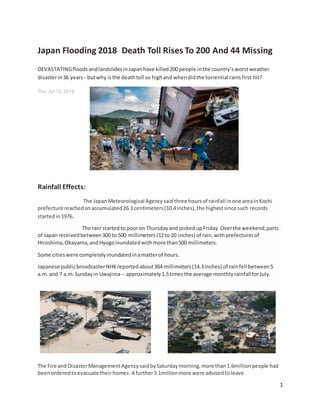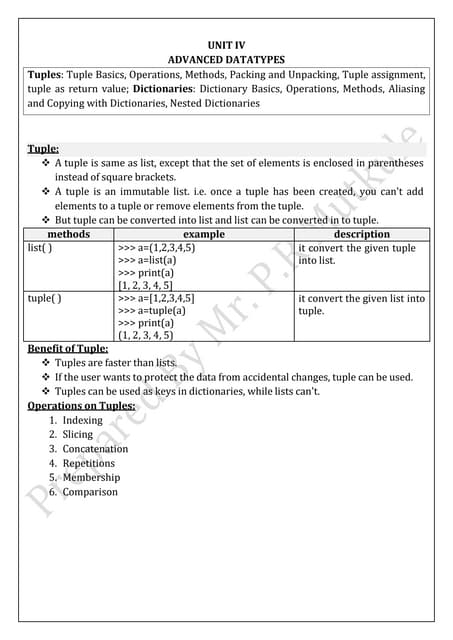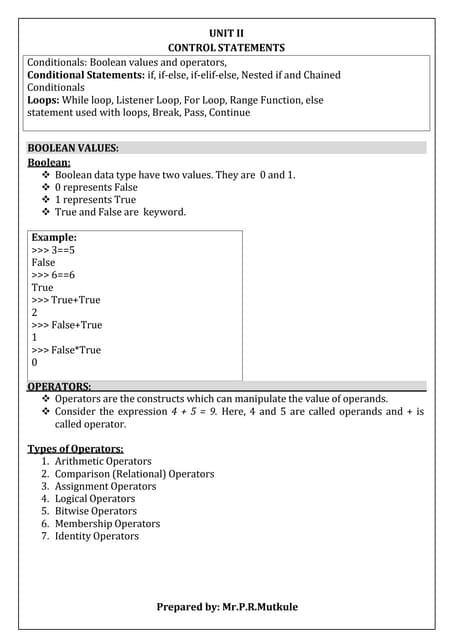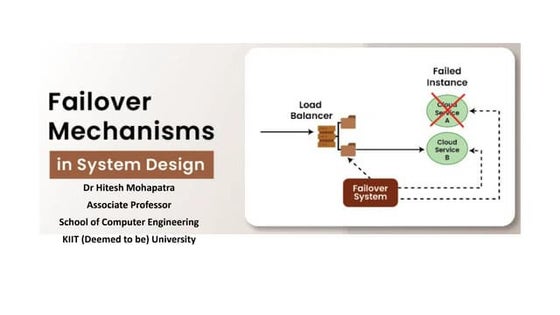Japan flooding 2018
- 1. 1 Japan Flooding 2018 Death Toll Rises To 200 And 44 Missing DEVASTATINGfloodsandlandslidesinJapanhave killed200 people inthe countryˇŻsworstweather disasterin36 years - butwhy isthe deathtoll so highand whendidthe torrential rainsfirst hit? Thu, Jul 12, 2018 Rainfall Effects: The JapanMeteorological Agencysaidthree hoursof rainfall inone areainKochi prefecture reachedanaccumulated26.3 centimeters(10.4inches),the highestsince such records startedin1976. The rain startedto pouron Thursdayand pickedupFriday.Overthe weekend,parts of Japanreceivedbetween300 to 500 millimeters(12to 20 inches) of rain,withprefecturesof Hiroshima,Okayama,andHyogoinundatedwithmore than500 millimeters. Some citieswere completelyinundatedinamatterof hours. Japanese publicbroadcasterNHKreportedabout364 millimeters(14.3inches) of rainfell between5 a.m.and 7 a.m.Sundayin Uwajima -- approximately1.5timesthe average monthlyrainfallforJuly. The Fire and DisasterManagementAgencysaidbySaturdaymorning,more than1.6millionpeople had beenorderedtoevacuate theirhomes. A further3.1millionmore were advisedtoleave.
- 2. 2 Rescue Efforts: More than 70,000 rescue workersare scouringthroughdebrisandmudin a bidto findpeople whoare still missing. "Rescues,savinglivesandevacuationsare arace againsttime,"Mr Abe saidas he metwitha governmentcrisiscell setuptorespondtothe disaster. "There are still manypeoplewhose safetyhasyettobe confirmed,"he added. As rescue effortscontinued,watershortagesalsoimpactedlocal hospitals,withreportsof delayed surgeriesanddialysispatientshavingtobe transferredinordertoundergotreatment. The governmentsenttrucksof waterto the disasterareas,butfearswere growingthatsurvivorswere not receivingenoughfluidsinthe soaringsummerheatdue totightsupplies. Why have somany people died? Extreme downpours: The deadly flooding began on July 5 and was caused by unprecedented heavy rain at the end of June, worsened by Typhoon Prapiroon, which made landfall on July 3. Disasterexpertsare nowwarningclimate change couldfuel more torrential raininthe future. Takashi Okuma,an emeritusprofessoratNiigataUniversitywhostudiesdisasters,said:ˇ°The governmentisjuststartingtorealize thatitneedstotake stepsto mitigate the impactof global warming.ˇ± Many of the communitieshitwereinmountainslopesandfloodplainspreviouslyuntouched by heavyrainfall butdozensof people were killedinasimilardisasterlastyear. Chief CabinetSecretaryYoshihide Sugatoldanewsconference inTokyo."It'sanundeniablefactthat thissort of disasterdue to torrential,unprecedentedrainisbecomingmore frequentinrecentyears.ˇ±
- 3. 3 Search Of Survivors: The prefecturesof HiroshimaandOkayamahave beenthe worst affectedbyfloodingandlandslips,triggeredbytorrential rainsonFridayandSaturday. Several towns inthe regionhave reported more than23 inchesof rainin the space of 18 hours, causing riversto bursttheirbanks, inundatinglow-lyingareasanddestabilisinghillsides. The townof Umaji,in Kochi Prefecture,recordedmore than47 inchesof raininthe space of 72 hours. Landslideshave causeddevastationinmountaincommunities,destroyinghomes,roadsandrailways.At the heightof the crisis,two millionpeople were toldtoevacuate theirhomesandtake shelterin communitycentres,schoolsandhospitals. Top governmentspokesmanYoshihideSugasaidTuesdaythat at least141 people hadbeenkilled.Suga said73,000 police,firemenandtroopswere taking part inthe rescue effort,with700 helicopters deployedtohelp. In Kumano,soldiersandotheremergencyworkerswere usingdiggersto clear crushedcars and mangledhomes,andchainsawsto cut up tree trunks. But theywere movingcarefully,lookingas theywentfor survivors,or the remainsof those killedinthe disaster. In one part of Kumano,the nose of a white car was justvisible underneaththe topfloorof a home that had beentorn from the rest of the buildingandsweptdowna hillside. Water was still flowingfromthe surroundinghillsidesaroundthe feetof shellshockedresidents,some of whomweptas they sawtheir damageddistrict. In neighbouringOkayamaprefecture,rescue workersflewinhelicoptersoverareasthat are still submergedand otherwise unreachable,lookingforsignsof life. "As far as we could see from the helicopter,no-one isnow wavingforhelp,"a rescue workerfrom Kurashiki citytoldAFP.
- 4. 4 Local governmentofficialssaidpumpingtruckswere beingdeployedtohelprestore accessto some of the worst-hitareas,and on Monday floodwaterwas finallystartingto recede as the rains stopped. Landslide Risk: Evenas the rains letup, authoritieswarnedthe downpourshadloosened earthonhillsidesand mountainslopescreatingnewrisks. "We urge residentstoremaincautiousabout possible landslides,"aweatheragencyofficial toldAFP. Andwith manypeople stuckin modestlyequippedshelterswithfew possessions,orlivingindamaged homeswithno runningwater or electricity,the risingtemperaturesposedanew problem, authorities said. At one pointaround five millionpeople were toldtoevacuate,butthe ordersare not mandatory and many people remainedathome,becomingtrappedbyrapidlyrisingwateror suddenlandslides.
- 5. 5 Industry: By 7 Julyno bullettrains were runningwestof Shin-OsakaStation andthe West JapanRailwayCompany officialswere uncertainwhenthe trainswouldbe runningagain.[21] The widespreadcancellationof trainsstrandednumeroustravelers;some bullettrainswere utilizedas temporaryhotels.[20] Some automakers(Mitsubishi Motors &Mazda Motor) haltedproductionasthe rain andfloodingdisruptedthe companies'supplychainsandriskedthe safetyof workers.[19] Other companiessuchas DaihatsuandPanasonicsuspendedoperationsatplantsuntil debriswasclearedand the waterrecededfromthe factories.[15] The Asahi AluminiumIndustrialCompanyplant inOkayama explodedonJuly6,afterworkershadevacuatedduringthe flooding.





![5
Industry:
By 7 Julyno bullettrains were runningwestof Shin-OsakaStation andthe West
JapanRailwayCompany officialswere uncertainwhenthe trainswouldbe runningagain.[21]
The
widespreadcancellationof trainsstrandednumeroustravelers;some bullettrainswere utilizedas
temporaryhotels.[20]
Some automakers(Mitsubishi Motors &Mazda Motor) haltedproductionasthe
rain andfloodingdisruptedthe companies'supplychainsandriskedthe safetyof workers.[19]
Other
companiessuchas DaihatsuandPanasonicsuspendedoperationsatplantsuntil debriswasclearedand
the waterrecededfromthe factories.[15]
The Asahi AluminiumIndustrialCompanyplant
inOkayama explodedonJuly6,afterworkershadevacuatedduringthe flooding.](https://image.slidesharecdn.com/japanflooding20181-180917081849/85/Japan-flooding-2018-5-320.jpg)


































